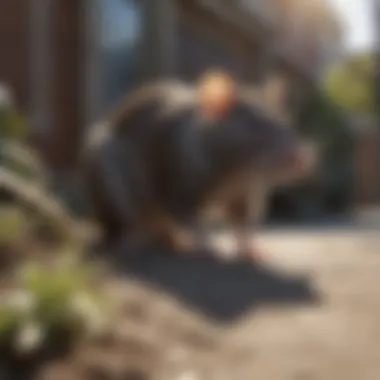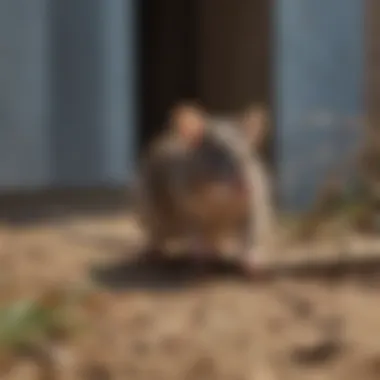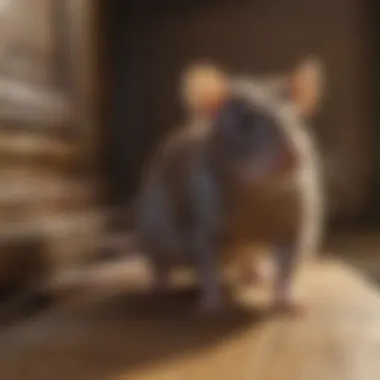Essential Rat Control Strategies for Charleston


Intro
In Charleston, South Carolina, managing a rat infestation is not just an issue of aesthetics; it is a serious concern for health and safety. Rats can carry various diseases and cause significant damage to properties. While they are prevalent in many urban areas, understanding how to identify these pests and implement effective control methods is crucial for homeowners. This guide aims to equip you with knowledge on detection, prevention, and treatment strategies tailored to the specific needs of Charleston residents.
Pest Identification
Detailed descriptions of common pests
In Charleston, the most commonly encountered rat species are the Norway rat and the roof rat.
- Norway Rat: This species is larger and robust, with a body length of about 9-11 inches. Their fur is typically brown or gray and they have a blunt snout. Norway rats prefer to dwell in burrows or in sewers.
- Roof Rat: Slightly smaller and more agile, roof rats have a slender body that measures about 6-8 inches. They have a pointed snout and often have a black or brown coat. These rats are more likely to inhabit roofs or upper levels of buildings.
Signs and symptoms of infestations
Identifying a rat problem early can prevent larger issues down the line. Look for the following signs:
- Droppings: Fresh droppings, which are about the size of a grain of rice, can often be found in areas where rats are active.
- Gnaw Marks: Inspect for gnawed holes in walls, furniture, or food packaging.
- Nesting Materials: Shredded paper, fabric, or insulation may indicate nesting sites.
- Footprints and Tail Traces: In dusty areas, you may notice footprints or tail streaks.
"Effective rat control begins with proper identification of the species and acknowledging the signs of infestation."
Prevention Strategies
Home maintenance tips for pest prevention
Preventing a rat infestation requires proactive home maintenance. Consider these tips:
- Seal Entry Points: Inspect your home for gaps in walls, foundations, and around pipes. Use materials like steel wool to seal these openings.
- Proper Food Storage: Store food in airtight containers and avoid leaving pet food out overnight.
- Regular Cleaning: Maintain cleanliness in both indoor and outdoor areas. Avoid clutter that offers hiding spots.
Natural deterrents and barriers
Several natural deterrents can help keep rats away:
- Peppermint Oil: This essential oil can deter rodents due to its strong scent. Soak cotton balls in peppermint oil and place them in areas where you've seen evidence of rats.
- Ultrasonic Repellents: Devices that emit high-frequency sounds may confuse and deter rats from entering your home.
Treatment Options
Overview of chemical vs. natural treatments
When infestations occur, treatment options fall into two categories: chemical and natural. Chemical treatments often involve rodenticides, which can be effective but must be handled with care to avoid harm to pets and children. Natural treatments include traps and barriers that do not involve harmful substances.
Step-by-step guides for DIY treatments
For those considering Do-It-Yourself methods, follow this simple guide for using traps effectively:
- Choose the Trap: Select snap traps or live traps based on your preference.
- Location: Set traps where you’ve noticed signs of rats, placing them perpendicular to walls.
- Baiting: Use peanut butter or dried fruit as bait, placing a small amount on the trap.
- Check Regularly: Inspect the traps daily and remove any captured rats promptly.
By understanding the identification, prevention, and treatment strategies for rat control specific to Charleston, homeowners can effectively reduce the risk of rodent infestation. With well-informed actions, it is possible to maintain a rat-free environment.
Understanding Rat Infestations
Understanding rat infestations is vital for effective control strategies, particularly for residents of Charleston, South Carolina. This region's climate and urban environment create conditions that are favorable for rodent populations. Recognizing the signs of infestation and knowing the common species found here can lay the groundwork for prevention and management efforts. Homeowners must actively engage in identifying issues as early as possible to mitigate potential damages and health risks associated with these pests.
Signs of Rat Infestation
Distinguishing the signs of rat infestation is a primary step any homeowner should undertake. Some common indications include:
- Droppings: Rat feces are typically dark and elongated, resembling rice grains. Finding them around your home is a strong indicator of a rodent presence.
- Gnaw marks: Rats will chew on walls, wires, and furniture to maintain their ever-growing teeth. Look for fresh marks on wood or plastic materials.
- Nests: Rats often build nests from shredded paper, fabrics, or insulation material. Finding a nest in your home is a significant sign of infestation.
- Nocturnal activity: Hearing scratching or rustling noises at night can hint at rodents scurrying about. It’s essential to pay attention to these sounds, especially when they seem to originate from walls or ceilings.
Being vigilant about these signs can help catch an infestation in its early stages, preventing it from escalating further.
Common Rat Species in Charleston


In Charleston, two main rat species are often found: the Norway rat and the roof rat.
- Norway Rat: Larger and heavier, Norway rats prefer burrowing in soil or under structures. They are often brown or gray and can be found near food sources such as trash and gardens.
- Roof Rat: More slender than the Norway rat, roof rats have long tails and prefer to live in trees or attics. Their color ranges from black to brown. These rats are agile climbers and are often found in higher locations.
Familiarity with these species is important for targeting effective control measures tailored to their habits and habitats.
Health Risks Associated with Rats
Rats are not just a nuisance; they pose significant health hazards. Their presence can lead to various diseases, including:
- Leptospirosis: This bacterial infection can be contracted through water contaminated by rat urine, causing severe illnesses in humans.
- Hantavirus: Often transferred via aerosols from droppings or urine, this virus can lead to serious respiratory issues.
- Salmonellosis: It is a common foodborne illness that can occur when food is contaminated by rodent droppings.
A healthy home is one free from pests, and understanding these risks emphasizes the importance of maintaining effective rat control practices to protect family members and the community.
"Ignoring the signs of infestations can lead to health risks and increased damage to the home. Early detection is key."
By grasping the essential elements of rat infestations, homeowners can take proactive measures, ensuring a safer and more secure living environment.
Preventive Measures for Rat Control
Preventive measures are a crucial component in the rat control strategy for any household or community. By focusing on prevention, homeowners can minimize the risks of rat infestations and reduce the need for reactive measures later. This proactive approach not only protects property but also enhances health safety. The benefits of implementing effective preventive techniques are extensive, leading to a comfortable living environment where health risks associated with rats are mitigated.
Effective Sanitation Practices
Sanitation practices play a primary role in keeping rats at bay. Rats thrive in environments where food and waste are abundant. To deter these rodents, maintaining cleanliness is vital. Here are some essential sanitation practices:
- Regular Cleaning: Kitchen surfaces, appliances, and dining areas should be cleaned diligently to remove any food particles.
- Proper Waste Disposal: Garbage should be stored in sealed containers. Dispose of waste regularly to prevent accumulation.
- Pet Food Management: Store pet food in airtight containers and avoid leaving it out overnight.
By establishing consistent sanitation routines, households can reduce food sources that attract rats.
Sealing Entry Points
One of the most effective ways to prevent a rat infestation is by sealing potential entry points. Rats can squeeze through surprisingly small gaps, often measuring around half an inch wide. Thus, it is essential to inspect your property thoroughly. Key strategies include:
- Identify Vulnerable Areas: Look for holes around doors, windows, and foundations.
- Use Appropriate Materials: Seal gaps with materials like steel wool combined with caulk, or use concrete for larger openings.
- Regular Inspections: Periodically check sealing effectiveness and make necessary repairs.
By closing these entry points, the chances of rats invading your home significantly decline, allowing for a more secure living space.
Use of Natural Deterrents
Natural deterrents can serve as an additional line of defense against rats. These methods are often less intrusive and can be a part of an overall integrated pest management strategy. Some commonly used natural deterrents include:
- Essential Oils: Oils such as peppermint can deter rats. Soaking cotton balls in these oils and placing them in suspected areas can be effective.
- Cayenne Pepper or Garlic Powder: Sprinkling these substances in entry points may help repel rodents due to their strong odors.
- Ultrasonic Repellents: These emit sound waves that are unpleasant to rats but inaudible to humans.
Incorporating natural deterrents provides a gentle yet effective approach towards maintaining a rat-free environment, while also aligning with eco-friendly practices.
"Prevention is always better than cure."
By establishing proactive measures in sanitation, sealing entry points, and using natural deterrents, homeowners can significantly reduce the risk of rat infestations in Charleston.
Assessing the Severity of Infestations
Assessing the severity of rat infestations is a critical step in managing rodent problems effectively. Knowledge and understanding of an infestation’s extent can help property owners and pest control experts determine the most appropriate strategies. Careful evaluation can prevent minor issues from escalating into larger problems that are more difficult and costly to resolve.
When assessing the severity, it is essential to consider several key elements. These include the level of damage caused by the rodents, the frequency of sightings, and the signs of nesting and feeding behavior. By identifying these factors, homeowners can develop a clearer picture of the situation and respond accordingly.
A thorough assessment can lead to multiple benefits. For one, it allows for a more targeted approach to treatment, which can save time and resources. Additionally, understanding the severity can help prioritize actions, supporting timely interventions. Not only does this lead to a more effective response, but it also aids in developing long-term prevention strategies.
Inspection Techniques
Inspection is the first step in assessing rat infestations. Homeowners should conduct a systematic check of both the interior and exterior of their properties. Look for droppings, gnaw marks, and nesting materials. An effective inspection requires careful attention to detail.
Use the following techniques:


- Visual inspection: Scan areas where food is stored, like kitchens and pantries, for signs of rat activity.
- Check common entry points: These include gaps around pipes, doors, and windows that may allow rats to enter.
- Listen for sounds: Noises like scratching or scurrying indicate rodent presence.
To ensure thoroughness, it may help to consult with a pest control professional who can offer expertise in identifying subtle signs that a non-expert might miss.
Identifying Active Infestation Areas
Once the inspection is complete, pinpointing active infestation areas becomes the next priority. Focus on locations where activities are more pronounced. Rats tend to nest and forage in specific environments conducive to their survival.
Key areas to check include:
- Attics and crawl spaces: These secluded spots are often chosen for nesting due to their quietness and relative safety.
- Basements: Warm, dry basements can also attract rats.
- Garages and storage areas: These areas may contain food sources or clutter that can harbor nests.
Mark any area showing signs of infestation for further attention. This process ensures that the response is effective without overlooking critical hotspots.
Determining the Rat Population
Understanding the size of the rat population is vital for effective management. This can guide treatment options and help in estimating the anticipated duration to resolve the infestation.
To determine the population size:
- Assess droppings: Count the amount of droppings found, as a higher number could indicate a larger population.
- Monitor activity: Set up traps or bait stations to gauge how quickly they are being used; increased activity can denote higher numbers.
- Look for footprints: In certain conditions like dusty surfaces, rat footprints can provide insights into the number of rodents.
Measuring the rat population is not just about numbers. It also informs whether a localized approach is sufficient or if a more comprehensive solution is necessary.
Proper assessment is the key to effective control. By understanding the severity, one can take informed actions that lead to successful pest management.
Treatment Options for Active Infestations
Addressing a rat infestation promptly is critical for maintaining a healthy living environment. Once rats are detected, it is crucial to take immediate action to limit their population and prevent damage to property. Treatment options should focus on methods that are effective in getting rid of existing rats while also considering the safety of inhabitants and pets in the home. The following subsections explore chemical treatments, trapping methods, and professional pest control services in detail.
Chemical Treatments
Chemical treatments often involve the use of rodenticides designed specifically for rat extermination. These substances can be highly effective; however, they also carry risks. When utilizing chemical approaches, it is important to consider factors like the potential for harm to non-target species, which includes pets or local wildlife.
When selecting a chemical treatment:
- Choose the Right Product: Some rodenticides are anticoagulants which inhibit clotting in the rats, causing them to die from internal bleeding. Others might use different mechanisms, such as neophobia to deter initial consumption.
- Placement is Key: Proper placement of bait stations ensures that only the targeted rodent has access while minimizing the risks to children and pets.
- Follow Instructions: It is imperative to adhere to safety guidelines on handling, applying, and disposing of chemical substances. Misapplication can lead to unintended consequences.
Using these treatments should always be done with caution and as part of a broader strategy that includes preventive measures.
Trapping Methods
Trapping is another effective means of controlling rat populations. This method can be particularly beneficial as it does not introduce harmful chemicals into the environment. Various trapping techniques exist, with each having its advantages and disadvantages.
- Snap Traps: These are often favored for their quick action in killing the rodent. Proper baiting and placement near active rat areas can enhance effectiveness.
- Live Traps: For those seeking a more humane solution, live traps allow for the capture of rats without killing them. However, it’s crucial to release them far away from residential areas to prevent return.
- Multiple-Catch Traps: These traps can catch numerous rats at once and are effective in areas with significant infestations.
Proper monitoring and regular checks of traps are essential. This ensures that trapped rats are dealt with promptly, mitigating any potential suffering.
Professional Pest Control Services
In some situations, the complexity or severity of infestations necessitates professional intervention. Professional pest control services bring expertise and resources that typical homeowners may lack.
- Assessment and Planning: Professionals evaluate the property and create tailored plans focusing on both removal and prevention of future infestations.
- Advanced Treatments: They have access to professional-grade chemical treatments that are often not available to the public. Their usage is more regulated, which can lead to safer application.
- Long-Term Solutions: Pest control companies often provide ongoing monitoring and maintenance, ensuring that infestations do not recur. This is particularly important in areas prone to rat activity.
Engaging professional services can save time and provide peace of mind. It can also prove more effective in the long run, thereby safeguarding the health of the residents.
"Choosing the right treatment option is essential in ensuring effective rat control while prioritizing safety for all inhabitants."
In summary, it is critical to evaluate each treatment option carefully to ensure its appropriateness for the specific situation. Each method has its own set of benefits and challenges, and often, the best approach will incorporate multiple strategies for comprehensive control.
Long-Term Rat Management Strategies
Long-term rat management strategies are essential for maintaining a rodent-free environment in Charleston, SC. Such strategies focus on proactive measures that prevent infestations from taking hold, rather than just addressing them after they occur. Effective long-term management involves consistent practices that not only deal with existing problems but also reduce the likelihood of future invasions. A comprehensive approach is crucial in protecting both homes and public health.


Ongoing Monitoring and Maintenance
Regular inspections are a cornerstone of effective rat management. Homeowners should routinely check areas that are prone to infestations, such as basements, attics, and crawl spaces. This monitoring helps identify early signs of rat activity, like droppings or gnaw marks. Documenting these inspections can assist in forming a pattern over time, making it easier to devise targeted strategies.
Key actions include:
- Regular cleanliness: Keeping outdoor spaces tidy reduces potential nesting sites.
- Proper food storage: Food should be sealed tightly and stored in rodent-proof containers.
- Routine checks of entry points: Inspect and repair any gaps or holes in walls, foundations or roofing.
Overall, ongoing monitoring is not merely a reactionary measure; it is a proactive commitment to ensuring that your living space remains inhospitable to rodents.
Community Awareness Programs
Communities can greatly enhance their rodent control efforts through awareness programs. Engaging residents through educational workshops and informational seminars strengthens community resilience against infestations. When homeowners understand the shared impact of rat problems, they become more vigilant in their own properties.
Programs can cover:
- Identifying risk factors in the local environment that foster rodent populations.
- Best practices for waste disposal to limit food sources available to rats.
- Collaborative efforts to monitor public spaces for signs of infestations.
Creating strong community bonds focused on a common goal can lead to impactful long-term results in rat management. People working together are more likely to adopt recommended practices, which can lead to a significant reduction in rodent populations.
Legal Considerations and Regulations
Understanding the legal framework surrounding pest control is essential for homeowners. In Charleston, there are specific regulations concerning the use of pesticides and traps. Adhering to these laws ensures not only personal safety but also environmental protection.
Important aspects to consider include:
- Licensing: Some methods of rat control require professional licenses. Using unverified methods can lead to fines.
- Humane treatment: Many jurisdictions advocate for humane methods of pest control, influencing how infested properties may be treated.
- Reporting requirements: In some areas, you are required to report significant infestations.
By staying informed about local laws, homeowners can ensure they are compliant while effectively managing rat populations in their vicinity.
Misconceptions About Rat Control
Understanding the misconceptions surrounding rat control is critical for effective management strategies. Many homeowners in Charleston, SC, hold beliefs that hinder their ability to address rat infestations efficiently. Clear, factual information is essential not only for the success of eradication efforts but also for educating the public about rodent behavior. Once these misconceptions are debunked, individuals can implement better practices to ensure a rodent-free environment in their homes.
Debunking Common Myths
Several myths persist in discussions about rat control. Addressing these myths provides a foundation for more effective pest management.
- Myth: Rats are only a problem in urban areas. This misconception overlooks the fact that rats can thrive in rural as well as suburban environments. In Charleston, they are adaptable and can easily find shelter in homes, gardens or parks.
- Myth: All traps are equally effective. Not all traps function the same way. Different types, such as snap traps, glue traps, or electronic traps, serve distinct purposes. Choosing the appropriate trap based on the specific situation dramatically affects its success rate.
- Myth: If you see one rat, there are no others. Rats are social creatures, living in colonies. Observing one rat often indicates the presence of many more. This myth can lead to complacency, allowing a small problem to escalate into a larger infestation.
- Myth: Natural remedies are sufficient for control. While natural deterrents can assist in prevention, they usually cannot handle an established infestation. Combining different control strategies yields the best results.
- Myth: Once youExterminate rats, they never come back. Without sustainable practices to manage attractants and entry points, new rats will inevitably move in. It is critical to maintain ongoing prevention methods to keep them away.
Clarifying Pest Control Techniques
Not all pest control techniques work universally. Understanding different approaches is vital for effective rat management.
- Baiting Strategies: Using poison bait can be risky and should be done with caution. It requires precise placement to avoid harm to pets and non-target wildlife. This technique is effective when combined with secure trapping methods.
- Trapping Methods: Baiting traps with appealing food specific to the rat's diet is vital for securing success. Placement is equally important—traps should be in areas where rat activity has been noted. Successful trapping requires frequent checks to dispose of captures humanely and promptly.
- Professional Pest Control: Hiring experts can provide valuable insight and methods that exceed basic DIY attempts. Professionals offer comprehensive plans based on extensive knowledge of local rodent behavior, assess homes for vulnerabilities, and implement long-term strategies that an average homeowner might overlook.
By addressing these myths and clarifying pest control techniques, homeowners and house owners can be well-equipped to tackle rat infestations effectively. The right approach ensures a more pest-free Charleston, contributing to a healthier living environment.
End
The conclusion of this article emphasizes the necessity of comprehensive rat control measures for homeowners in Charleston, South Carolina. Given the unique climate and ecology of this region, understanding and addressing rat infestations becomes crucial. The potential health risks and property damage that rats can cause make it imperative for residents to adopt proactive and effective strategies.
A significant focus should be placed on prevention as the first line of defense. This includes good sanitation, creating barriers against entry, and utilizing natural deterrents. Not only do these measures help to keep homes rodent-free, but they also promote a more pleasant living environment.
When an infestation does occur, timely identification and treatment become critical. Understanding the variety of treatment options available—from chemical solutions to humane trapping methods—enables homeowners to choose the approach best suited for their situation.
Furthermore, engaging in long-term management strategies ensures that rat control is not a one-time fix, but rather an ongoing commitment. Continuous monitoring and community awareness can significantly enhance the effectiveness of individual efforts, creating a collective response to the issue of rat infestations.
"An informed homeowner is the most effective guardian against rodent infestations."
This article encapsulates various strategies for preventing and managing rats. By synthesizing practical advice, awareness of health risks, and insights into local conditions, homeowners can approach rodent control with confidence and knowledge.
Summary of Best Practices
To conclude, here are some best practices for effective rat control in Charleston:
- Maintain Cleanliness: Regularly clean spaces to eliminate food sources.
- Seal Entry Points: Close gaps in windows, doors, and foundations to prevent access.
- Use Deterrents: Implement natural repellents such as peppermint oil or ultrasonic devices.
- Conduct Regular Inspections: Periodically check for signs of rat activity in and around homes.
- Choose Appropriate Treatments: Select methods that align with personal and environmental values, including chemical or humane approaches.
- Stay Informed: Keep up-to-date with local regulations and best practices in pest control.
By adhering to these practices, residents can effectively contribute to a rat-free Charleston.



